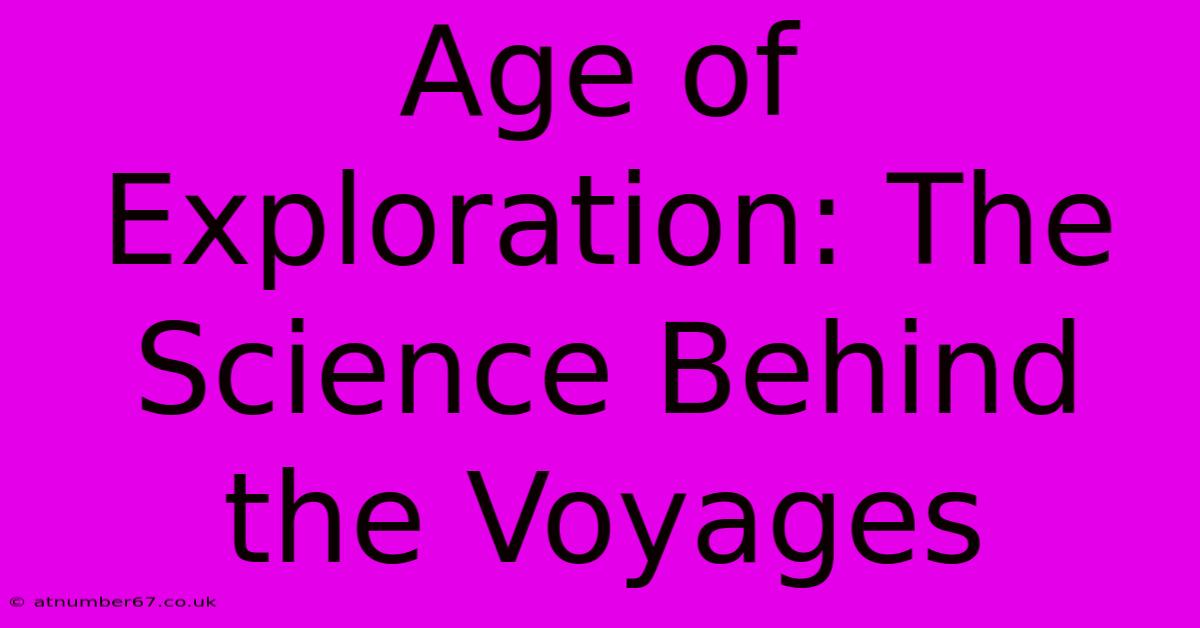Age Of Exploration: The Science Behind The Voyages

Table of Contents
Age of Exploration: The Science Behind the Voyages
The Age of Exploration (roughly 15th-17th centuries) wasn't just about daring adventurers and vast riches; it was a period of significant scientific advancement. The successful voyages across oceans were profoundly reliant on breakthroughs in navigation, cartography, shipbuilding, and even medicine. Let's delve into the scientific underpinnings that made these epic journeys possible.
Navigation: Charting a Course Across the Unknown
Accurate navigation was paramount. Early explorers relied heavily on celestial navigation, utilizing the positions of the sun, moon, and stars to determine latitude. However, determining longitude proved significantly more challenging. This problem spurred advancements in several areas:
The Astrolabe and Quadrant:
These instruments, though not new to the Age of Exploration, were refined and widely used. The astrolabe measured the altitude of celestial bodies, crucial for calculating latitude. The quadrant provided a simpler, more robust alternative for this measurement.
The Mariner's Compass:
While the compass had existed for centuries, improvements in its design and accuracy were critical. Understanding magnetic declination (the variation between true north and magnetic north) became increasingly important for accurate navigation.
The Development of the Chronometer:
Determining longitude accurately required precise timekeeping. The invention and improvement of the chronometer, a highly accurate clock resistant to the effects of sea travel, revolutionized navigation. By comparing the time on the chronometer to the local time (determined by celestial observations), navigators could calculate their longitude. This was a game-changer, allowing for much more accurate charting of routes.
Cartography: Mapping the World
Accurate maps were essential for planning and executing voyages. The Age of Exploration saw a significant shift in cartography:
Improving Map Projections:
Early maps were often inaccurate, especially concerning landmasses and distances. Innovations in map projections (methods of representing a spherical surface on a flat map) significantly improved accuracy and provided a better understanding of global geography.
Data Collection and Compilation:
Explorers meticulously documented their journeys, collecting data on coastlines, currents, winds, and other geographical features. This information was then compiled to create increasingly accurate and detailed maps. The exchange of cartographic data between nations further accelerated the process.
Shipbuilding: Crafting Vessels for the Open Ocean
The success of exploratory voyages relied heavily on improved shipbuilding techniques:
The Caravel and Carrack:
These ship designs, featuring improved maneuverability and seaworthiness, were well-suited for long ocean voyages. Their design incorporated innovations like lateen sails (allowing sailing closer to the wind) and better hull construction techniques.
Navigation Instruments and Tools:
Ships became more than just vessels; they were mobile laboratories. Advanced navigation equipment and tools were integrated into their design, allowing for more accurate navigation and data collection at sea.
Medicine and Provisions: Ensuring Crew Survival
Long voyages presented significant challenges to the health and well-being of sailors:
Scurvy Prevention:
The discovery of the importance of Vitamin C in preventing scurvy was a crucial breakthrough. While the exact mechanism wasn't understood at the time, the inclusion of citrus fruits in the sailors' diets significantly reduced mortality rates.
Improved Ship Sanitation:
Better sanitation practices and improved food preservation techniques contributed to reducing disease transmission and improving the health of the crew.
Conclusion: A Scientific Revolution at Sea
The Age of Exploration was not just about the discovery of new lands; it was a period of remarkable scientific progress. The advancements in navigation, cartography, shipbuilding, and medicine were interconnected and crucial for the success of these daring voyages. These scientific developments had a lasting impact, shaping our understanding of the world and laying the groundwork for future exploration and scientific discovery. The legacy of this era continues to inspire and inform our understanding of the scientific spirit and its power to transform human history.

Thank you for visiting our website wich cover about Age Of Exploration: The Science Behind The Voyages. We hope the information provided has been useful to you. Feel free to contact us if you have any questions or need further assistance. See you next time and dont miss to bookmark.
Featured Posts
-
John Mellencamps Daughter The Next Generation Of Artists
Apr 15, 2025
-
Molly Littles Age The Medias Portrayal
Apr 15, 2025
-
Que Son Las Coplas And How To Write Them
Apr 15, 2025
-
Dj Toxic Son Of Dragon The Beat That Wont Stop
Apr 15, 2025
-
A Prayer For My Daughters Birthday Prosperity And Peace
Apr 15, 2025
